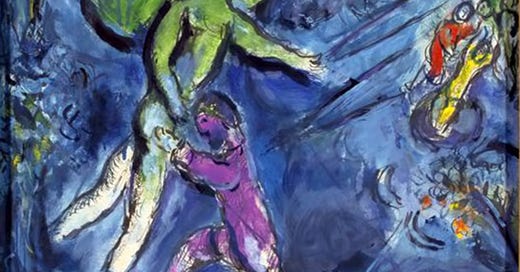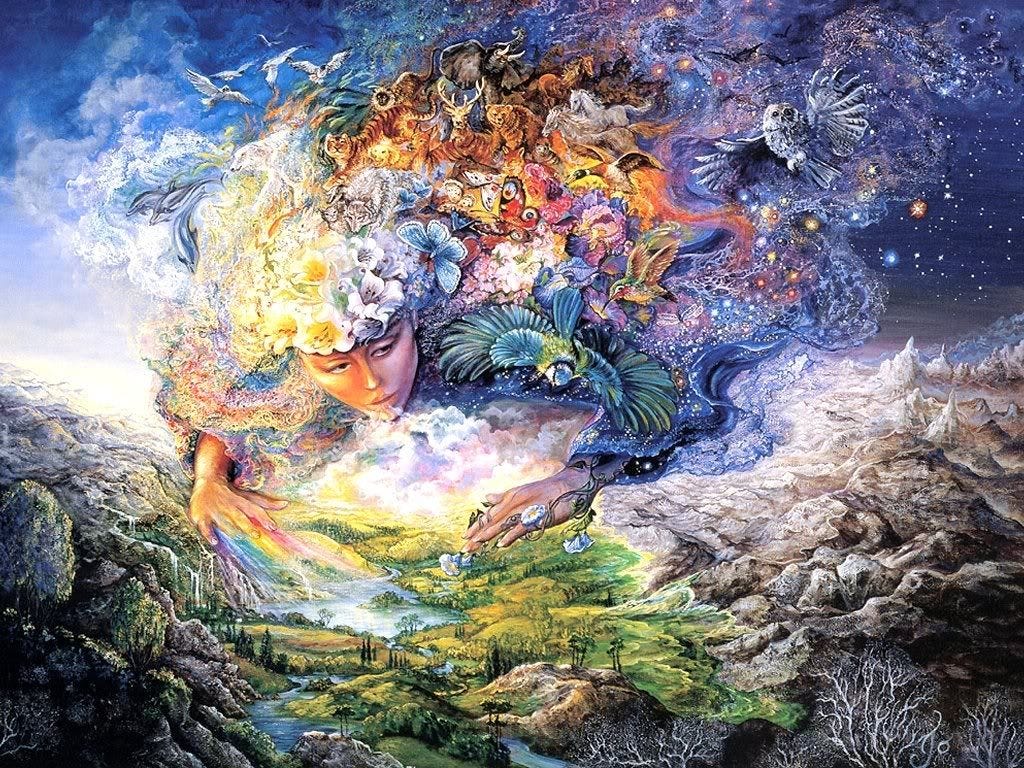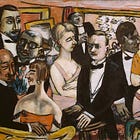Your name will no longer be Jacob, but Israel, because you have struggled with God and with humans and have overcome.
(Genesis 32:28)
This verse encapsulates themes of identity, transformation and the dual nature of human struggle (both divine and earthly) and serves as an abiding symbol of resilience and spiritual evolution.
We can consider Jacob’s struggles and subsequent name change as an allegorical testament to the complexities of faith, morality and human relationships. By doing so, we can better understand how these challenges shape our lives. Then, building on this, we can posit that by embracing a First Spiritual Principle of Humanity - namely, recognizing the inherent and sacred worth and dignity of every person - we will be afforded a pathway to reconciling and overcoming evil. How so?
“Because you have struggled with God and humans and have overcome.” The circular reasoning will sort itself out as we continue.
The grace of Divine Assistance is always granted to those with a pure heart (who act from love rather than selfish ego) and who earnestly request it. Assistance may arrive directly from God (or however you envisage Transcendent Reality), or the help you need may arrive via another human being who was divinely inspired to offer it.
This spiritual concept of “letting go and letting God” is often expressed simply as “surrender.” I don’t cotton to this abstruse notion lock, stock and barrel. Surrender what? Free will? I believe that by inviting transcendent reality into our lives, we freely submit both to a dialogue and cooperative relationship with transcendence. Granted, this is easier if transcendence is anthropomorphized.
But let’s continue with our examination of demonology as we aim to explore the intersectionality of religious metaphor and psychology and address the metaphysical question of evil. Hopefully, this endeavor will prove useful.
For my part, overcoming literal interpretations of Biblical teachings, combined with at least a cursory understanding of depth psychology and quantum field theory, led to what the Ancient Greeks called metanoia - spiritual conversion accompanied by a new, rational worldview of Heaven and Earth. A new way of seeing things. My spiritual journey, once only a small seed of potentiality, has evolved today into a 40-odd-year old flower that continues to bloom, although I myself am much older now (80).
Scripture teaches us that New Life begins around 40. Forty is a ubiquitous number repeatedly found in sacred scripture - 159 times, to be exact.1
The universal and enigmatic concept of metaphysical evil straddles the realms of theology, psychology and folklore. Within this intricate and immensely interesting nexus, demonology - originally a Christian term for the doctrine of demons, fallen angels and evil spirits - finds itself renegotiated through the lenses of religious metaphor and anomalous psychology.2 Viewed through this lens, the Cosmic Boogeyman hypothesis can be thoroughly debunked.
Christian Demonology — Evil as Metaphor
In Christian theology, demonology represents the study of demons or evil spirits, often to understand their nature, hierarchy and influence on both the individual and the world. These demonic figures serve as metaphors for the metaphysical evil that pervades the human condition. Traditionally, demons are fallen angels, led by Lucifer, who actively seek to lead human beings astray and into sin.3 This notion is rejected by Rational Spirituality.
Some say Satan’s greatest accomplishment was to make us humans believe that he doesn’t exist. I say those who believe in a Deceiver-in-Chief do so to scapegoat behavior not in their own best interests. This lesson was frequently taught in the Flip Wilson School of Demonology. Such delusions can be detrimental to spiritual growth.
On a more serious note, I prefer to argue from existentialism against the idea of an omnipotent evil entity:
Externalizing evil to a figure like Satan could be considered bad faith, an avoidance of individual responsibility. Jean-Paul Sartre would argue that we are condemned to be free and must accept the burden of defining ourselves.
Evil in the world is the result of the complex interaction of free will, systems, and the inherent limitations of a still-evolving universe.
Christian demonology often serves as an allegorical interpretation of evil, reinforcing the need for virtue and avoidance of sin. It sets the moral compass by embodying the antithesis of Christian values primarily for pedagogic convenience. However, when viewed metaphorically, demons become symbols of internal struggles, ethical dilemmas and the darker aspects of human nature, rather than unpleasant corporeal beings with malevolent intentions.
Anomalous Psychology — The Jungian Shadow
Anomalous psychology, influenced heavily by Carl Jung, diverges from the Christian model, yet resonates with some of its themes. Jung's concept of the Shadow represents the darker aspects of the psyche the conscious mind chooses to ignore. In fact, it denies these dark aspects exist by burying them deep within the psyche.4
These repressed dark elements can manifest both in individual and collective actions that society routinely deems 'evil.' For Jung, existential evil is not a separate entity but a part of the human condition, a shadowy reflection of our fears, anxieties and repressed desires.
To reiterate, the Jungian perspective suggests that the 'demons' within us are fragmented parts of our own self that we've disowned. When these fragments are left unaddressed, they often manifest as pathological behavior. In this way, demonic possession in Christian texts can metaphorically refer to the human predisposition to project their inner chaos onto external entities.
Exorcism, commonly viewed as a religious rite for expelling demonic entities, can also be interpreted as a psychological process aimed at confronting the "Shadow Self.” In this context, the act of exorcism serves as a ritualized confrontation between the individual and their repressed fears, desires or traumas. If "successful," the exorcism may catalyze a journey towards self-awareness and healing, forcing the individual to reckon with their inner complexities, consequentially initiating a process of psychological integration and emotional reconciliation.
Metaphysical Evil
The term 'metaphysical evil' serves as a conceptual bridge between Christian demonology and anomalous psychology. If demons are metaphorical representations of internal psychological struggles, then the metaphysical evil they represent can be understood as the pervasive, unquantifiable forces that push individuals toward destructive behavior.
For example, while Christian demonology would metaphorically describe the inclination towards harmful actions as a 'temptation by demons,' Jungian psychology would attribute such inclinations to the repressed parts of the psyche bubbling up to reveal themselves. In either case, the 'evil' exists as a complex array of factors — psychological, social and even cosmological — that exert influence upon human actions and decisions.
To recap: Though rooted in different intellectual and spiritual traditions, Christian demonology and anomalous psychology both offer unique yet overlapping insights into the nature of evil. When treated as metaphor and archetypal imagery, these perspectives enrich our understanding of the complex phenomenon we call 'evil,' opening new avenues for exploring the depths of the human psyche, as well as the metaphysical dimensions of existence.
Let’s return to the cosmological aspects that influence human activity, as previously intimated. This is where the rubber meets the road, so to speak.
Evil in Cosmology
In this instance, the term "cosmological" denotes a broader metaphysical, understanding of evil as it operates in the universe. This context encompasses ideas from Eastern philosophies and quantum field theory that suggest the universe is fundamentally interconnected, which also is a central tenet of Rational Spirituality. From this perspective, acts or manifestations of 'evil' are not individual or societal dysfunctions, but disturbances in the cosmic balance, an insight George Lucas named, “The Force.”
Allow a quick digression. Carl Jung was a great fan of the Star Wars movies and George Lucas was, in turn, deeply influenced by Jung. “The Force” in Star Wars is akin to Jung’s Collective Unconscious, a concept we defined in a previous essay as a subquantum energy/information field (link to essay in footnotes).5
Just as Jung posited a balance between the archetypal forces of the Shadow and the Self in the individual psyche, "The Force" also has its light and dark sides, embodying a universal struggle between good and evil that justly resonates with audiences.
Moreover, some religious traditions speak of evil as a force that is fundamentally woven into the very fabric of existence and must actively be counterbalanced by good. In more scientific terms, you could think of 'evil' as a form of entropy - a breakdown of order on a universal scale - that must be counteracted for the universe to maintain balance and thus avoid chaos. This cosmological perspective allows for a more holistic and rational understanding of evil, one that transcends individual and societal boundaries and relates evil to chaos.
It also evokes what some would call Divine Retribution. While we ourselves have used that term to convey an important methodology in cosmic balancing, we consider it to be another function of another subquantum field of energy/information we call Gaia.
This name was given not so much after the Greek Earth Goddess, but rather after James Lovelock’s scientific theory known as Gaia Theory. We emphasized the Gaia Field can serve as an instrument of cosmic balancing in our essay titled, The Looming Wrath of Gaia.6
Contrasting Demonology and Ponerology
Demonology and ponerology refer to two different areas of study. Both deal with the concept of evil, but in different ways.
Demonology, to recap, is the study of demons or evil spirits and their interaction with the human world. In religious traditions like Christianity, demonology often serves as a subset of theology, exploring the nature, history and activities of “demonic beings” as they relate theoretically to divine and human existence. It often includes discussions of possession, exorcism and the cosmic battle between good and evil.
We assert that Jungian archetypes, while not corporeal entities like demons, nonetheless possess a form of agency. They are not passive elements within the psyche, but rather dynamic forces that can significantly influence our thoughts, feelings, and behaviors.
When activated by external stimuli or internal processes, these archetypes, that reside in the Collective Unconscious, can be said to 'possess' the individual psyche, shaping our perceptions and driving us towards certain patterns of action. This 'possession', however, is metaphorical and fundamentally different from demonic possession. Archetypal agency operates through influence and symbolic expression, not through literal, physical control.7
Ponerology, a term popularized by Polish psychologist Andrew Łobaczewski, is the study of evil, particularly the origins and dynamics of evil on a social level. Originating from the Greek word "poneros" meaning "evil," ponerology aims to understand the causes of malevolent actions. Unlike demonology, ponerology is often approached from a scientific or psychological perspective and may involve the study of psychopathology, antisocial behavior and systems or institutions that perpetuate harm.
It’s noteworthy that when people, often very smart people, discuss or write about existential evil, they often, and maybe inadvertently, reference Satan and demonic evil spirits. In doing so, the conversation, or debate, then de facto jumps tracks to one about Christian theology rather than ponerology.
The theological doctrine of Christology, which defends substitutionary atonement (the idea a savior gives his life for the sins of others), necessitates the existence of Satan as a real material entity, not simply as symbol or metaphor. This is made explicit because Christianity teaches that Jesus himself was fully human. Logically, if we posit a human savior, we must also postulate a corporeal tempter.
Let’s conclude this exposition by briefly defining two terms that often will crop up in discussions of existential evil.
Psychopathy
Psychopathic individuals often exhibit traits that could be seen as manifestations of evil in the Machiavellian sense - manipulation, deception and a lack of moral or ethical constraints. This form of evil is not concerned with metaphysical origins but is rather a practical, mundane evil that seeks to exploit others for personal gain.8
Machiavellianism, in its original context, is a political theory that suggests that the end justifies the means (utilitarianism), even if those means involve deceit or cruelty. Psychopathic behavior fits well within this framework. An individual acts without concern for the ethical or emotional implications of their actions, often leaving a trail of human suffering in their wake. In this case, evil is seen as a functional strategy for achieving specific goals, devoid of spiritual dimensions and human conscience.
Sadly, we experience this phenomenon in government. It’s called pathocracy.
I shall accept the denomination of pathocracy for a system of government thus created, wherein a small pathological minority takes control over a society of normal people.
Andrew Łobaczewski, Political Ponerology9
An interpretation of ‘White Crucifixion’ by Marc Chagall. 10
The Number Forty. (article) It symbolizes trial, testing or judgment.
Anomalous psychology is a sub-discipline that studies phenomena which don't fit within established psychological theories. It approaches these phenomena from a scientific perspective. While related to the field of parapsychology, which also aims to understand unexplained phenomena, anomalous psychology is less committed to the idea that these phenomena are necessarily 'paranormal' or supernatural.
In the gnostic Gospel of Mary Magdalene, Jesus says sin is an illusion. It has no objective reality. It is only the way people think that gives sin importance. If one rejects the notion of sin, the Savior says, one allows the Good to come forward and take its rightful place as a guide to how to become a true human being. (Source)
The totality of the human mind, both conscious and unconscious. From the Greek psykhe, which means the soul, mind and spirit.
Agency may either be classified as unconscious, involuntary behavior, or purposeful, goal directed activity.
White can signify purity, surrender or even a blank slate, open for projection by the viewer. It may serve to universalize the specific suffering depicted, making it a canvas onto which any human suffering might be projected. The white may also draw attention to the figure of Christ, acting as a spotlight to emphasize his centrality amidst the chaos that surrounds him. It is as though Chagall is challenging viewers to recognize the universality of suffering and the interconnectedness of humanity.











